分词与独立主格结构
- 格式:docx
- 大小:17.97 KB
- 文档页数:3
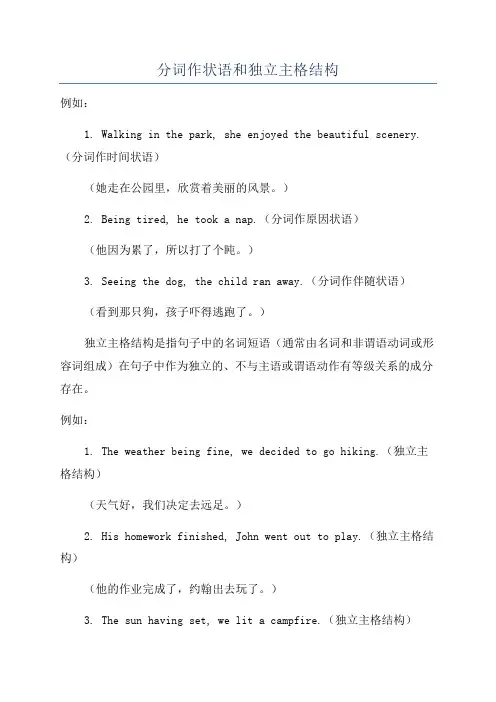
分词作状语和独立主格结构
例如:
1. Walking in the park, she enjoyed the beautiful scenery.(分词作时间状语)
(她走在公园里,欣赏着美丽的风景。
)
2. Being tired, he took a nap.(分词作原因状语)
(他因为累了,所以打了个盹。
)
3. Seeing the dog, the child ran away.(分词作伴随状语)
(看到那只狗,孩子吓得逃跑了。
)
独立主格结构是指句子中的名词短语(通常由名词和非谓语动词或形容词组成)在句子中作为独立的、不与主语或谓语动作有等级关系的成分存在。
例如:
1. The weather being fine, we decided to go hiking.(独立主格结构)
(天气好,我们决定去远足。
)
2. His homework finished, John went out to play.(独立主格结构)
(他的作业完成了,约翰出去玩了。
)
3. The sun having set, we lit a campfire.(独立主格结构)
(太阳已经落山,我们点燃了篝火。
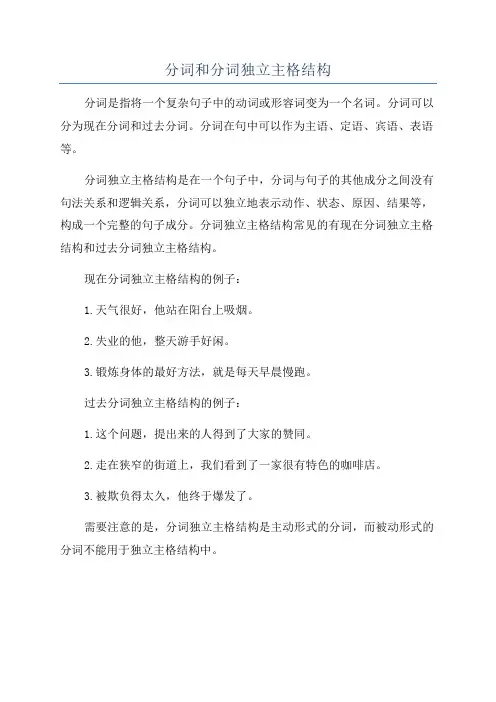
分词和分词独立主格结构
分词是指将一个复杂句子中的动词或形容词变为一个名词。
分词可以分为现在分词和过去分词。
分词在句中可以作为主语、定语、宾语、表语等。
分词独立主格结构是在一个句子中,分词与句子的其他成分之间没有句法关系和逻辑关系,分词可以独立地表示动作、状态、原因、结果等,构成一个完整的句子成分。
分词独立主格结构常见的有现在分词独立主格结构和过去分词独立主格结构。
现在分词独立主格结构的例子:
1.天气很好,他站在阳台上吸烟。
2.失业的他,整天游手好闲。
3.锻炼身体的最好方法,就是每天早晨慢跑。
过去分词独立主格结构的例子:
1.这个问题,提出来的人得到了大家的赞同。
2.走在狭窄的街道上,我们看到了一家很有特色的咖啡店。
3.被欺负得太久,他终于爆发了。
需要注意的是,分词独立主格结构是主动形式的分词,而被动形式的分词不能用于独立主格结构中。
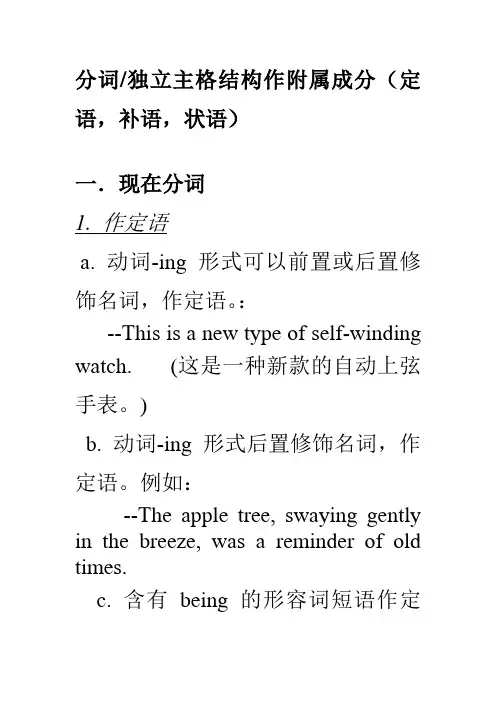
分词/独立主格结构作附属成分(定语,补语,状语)一.现在分词1. 作定语a. 动词-ing形式可以前置或后置修饰名词,作定语。
:--This is a new type of self-winding watch. (这是一种新款的自动上弦手表。
)b. 动词-ing形式后置修饰名词,作定语。
例如:--The apple tree, swaying gently in the breeze, was a reminder of old times.c. 含有being的形容词短语作定语,只能表示被动进行。
如:--Did you see that boy being questioned by the police? (你看到那个正在受警察盘问的男孩了吗?)2. 作状语a. 动词-ing形式作状语相当与各类副词从句--She begged him not to drink too much, reminding him that he'd have to drive home.(表示进一步说明)--Frankly speaking, I don't like people of his kind. (表示方式)--Putting down the newspaper, I walked over the window and looked out. (表示时间)--Not knowing what to do, the woman telephoned the police. (表示原因)--If going there by plane, we’ll have to pay twice as much. (表示条件)3.相当于状语从句的垂悬结构--Generally/broadly speaking, men can run faster than women.--Relatively speaking, the cost of living has remained static for several years.--She looks wonderful, considering she has been through so much.--Judging from his expression, he's in a bad mood.二.过去分词1. 定语a作前置定语--a born musician (= a natural musician)--a newly-born child--a married man (= a man who is married)--a recently-married womanb. 作后置定语---- the army defeated by the enemy, the army defeated for lack of ammunition.----the sum agreed upon----the people concerned (和所发生的事有关联的人)2. 作补语(as complement)a. 作主语补语----The quarrel of the night before seemed forgotten.b. 作宾语补语---They discovered him worn out by travel and exertion.3 相当于状语从句(as adverb clause equivalent)a. 动词-ed短语可以相当于副词短语,在句中作状语。
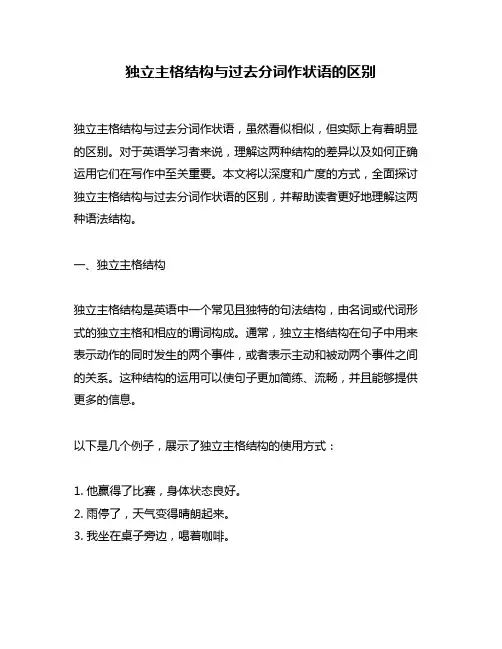
独立主格结构与过去分词作状语的区别独立主格结构与过去分词作状语,虽然看似相似,但实际上有着明显的区别。
对于英语学习者来说,理解这两种结构的差异以及如何正确运用它们在写作中至关重要。
本文将以深度和广度的方式,全面探讨独立主格结构与过去分词作状语的区别,并帮助读者更好地理解这两种语法结构。
一、独立主格结构独立主格结构是英语中一个常见且独特的句法结构,由名词或代词形式的独立主格和相应的谓词构成。
通常,独立主格结构在句子中用来表示动作的同时发生的两个事件,或者表示主动和被动两个事件之间的关系。
这种结构的运用可以使句子更加简练、流畅,并且能够提供更多的信息。
以下是几个例子,展示了独立主格结构的使用方式:1. 他赢得了比赛,身体状态良好。
2. 雨停了,天气变得晴朗起来。
3. 我坐在桌子旁边,喝着咖啡。
从这些例子可以看出,独立主格结构的谓词部分常常是一个动词的过去分词形式。
这与过去分词作状语的形式有点类似,但它们之间有着不同的用法和含义。
二、过去分词作状语过去分词作状语是一种常见的状语结构,用来修饰动作的方式、原因、时间或条件。
过去分词作状语通常位于句子开头或句子的中间,用来修饰整个句子或其中的某个成分。
它可以提供额外的信息,丰富句子的意义和表达。
以下是几个例子,展示了过去分词作状语的使用方式:1. 穿过森林,他找到了一家小屋。
2. 因为下雨了,他没有出去玩。
3. 在经历了一番波折之后,他最终成功了。
从这些例子可以看出,过去分词作状语的谓词部分也是一个动词的过去分词形式。
然而,过去分词作状语强调的是修饰整个句子或其中一个成分的状语关系,而不是像独立主格结构那样突出两个同时发生的事件或主动和被动事件之间的关系。
三、区别与用法尽管独立主格结构和过去分词作状语的形式相似,但它们之间存在着明显的区别。
了解这些区别可以帮助我们更加准确地运用这两种结构,并提高写作的表达能力。
独立主格结构强调的是两个同时发生的事件或主动和被动两个事件之间的关系。
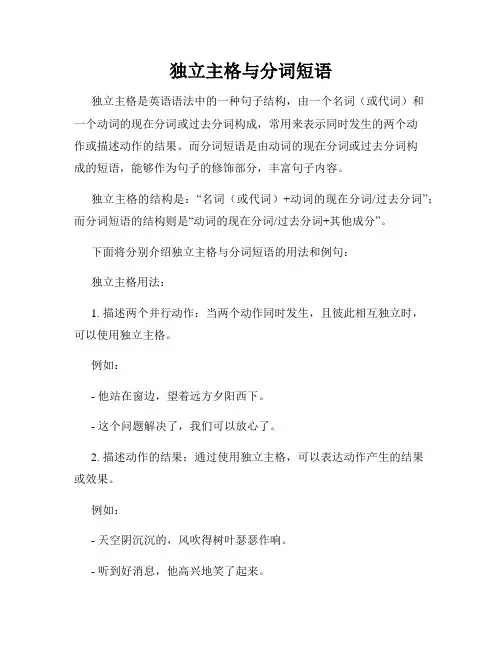
独立主格与分词短语独立主格是英语语法中的一种句子结构,由一个名词(或代词)和一个动词的现在分词或过去分词构成,常用来表示同时发生的两个动作或描述动作的结果。
而分词短语是由动词的现在分词或过去分词构成的短语,能够作为句子的修饰部分,丰富句子内容。
独立主格的结构是:“名词(或代词)+动词的现在分词/过去分词”;而分词短语的结构则是“动词的现在分词/过去分词+其他成分”。
下面将分别介绍独立主格与分词短语的用法和例句:独立主格用法:1. 描述两个并行动作:当两个动作同时发生,且彼此相互独立时,可以使用独立主格。
例如:- 他站在窗边,望着远方夕阳西下。
- 这个问题解决了,我们可以放心了。
2. 描述动作的结果:通过使用独立主格,可以表达动作产生的结果或效果。
例如:- 天空阴沉沉的,风吹得树叶瑟瑟作响。
- 听到好消息,他高兴地笑了起来。
分词短语用法:1. 修饰名词:分词短语可以作为形容词,修饰名词或代词。
例如:- 坐在街边的那个女孩正在读一本书。
- 那个弄脏了衣服的男孩是我的朋友。
2. 修饰句子:分词短语也可以修饰整个句子,相当于一个独立的动作或状态。
例如:- 跑着进屋,他大声喊道:“我回来了!”- 乘坐旅游巴士,他们欣赏着窗外美景。
需要注意的是,独立主格和分词短语都是非限定性短语,在句中一般用逗号与主句分开。
此外,使用独立主格和分词短语能够使句子更加丰富多样,增加句子的表达力。
总结:独立主格和分词短语是英语中常见的句子结构和修饰成分。
独立主格常用于表达两个并行动作或动作结果;而分词短语常用于修饰名词或整个句子。
它们的灵活运用可以使句子更加生动、丰富,提升文章的表达效果。
(字数:509)。
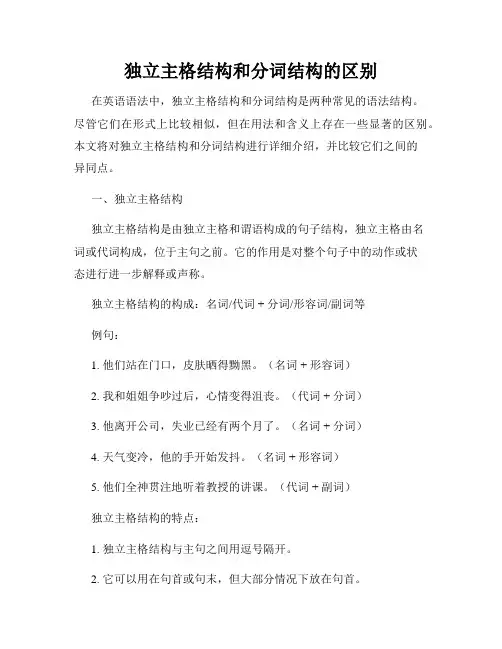
独立主格结构和分词结构的区别在英语语法中,独立主格结构和分词结构是两种常见的语法结构。
尽管它们在形式上比较相似,但在用法和含义上存在一些显著的区别。
本文将对独立主格结构和分词结构进行详细介绍,并比较它们之间的异同点。
一、独立主格结构独立主格结构是由独立主格和谓语构成的句子结构,独立主格由名词或代词构成,位于主句之前。
它的作用是对整个句子中的动作或状态进行进一步解释或声称。
独立主格结构的构成:名词/代词 + 分词/形容词/副词等例句:1. 他们站在门口,皮肤晒得黝黑。
(名词 + 形容词)2. 我和姐姐争吵过后,心情变得沮丧。
(代词 + 分词)3. 他离开公司,失业已经有两个月了。
(名词 + 分词)4. 天气变冷,他的手开始发抖。
(名词 + 形容词)5. 他们全神贯注地听着教授的讲课。
(代词 + 副词)独立主格结构的特点:1. 独立主格结构与主句之间用逗号隔开。
2. 它可以用在句首或句末,但大部分情况下放在句首。
3. 独立主格中的名词或代词通常是指句子主语的人或事物。
4. 独立主格结构不会影响句子的主谓结构。
二、分词结构分词结构是由分词(动词的现在分词或过去分词形式)加上修饰成分构成的结构。
它可以修饰名词或代词,表示该名词或代词的状态、特征或所处的位置等。
分词结构的构成:分词 + 修饰成分例句:1. 我看到他走在街上。
(现在分词)2. 这是我买的新书。
(过去分词)3. 坐在那里的女孩是我的朋友。
(现在分词)4. 穿着红色连衣裙的是我的姐姐。
(现在分词)5. 坐在教室后排的学生都很安静。
(现在分词)分词结构的特点:1. 分词结构修饰前面的名词或代词,起形容词的作用。
2. 分词可以是现在分词(-ing形式)或过去分词(-ed形式)。
3. 分词结构可以放在被修饰词的前面或后面。
4. 分词结构与被修饰词之间没有逗号隔开。
区别:1. 构成差异:独立主格结构由名词或代词加上分词/形容词/副词等构成,而分词结构则是由分词加上修饰成分构成。
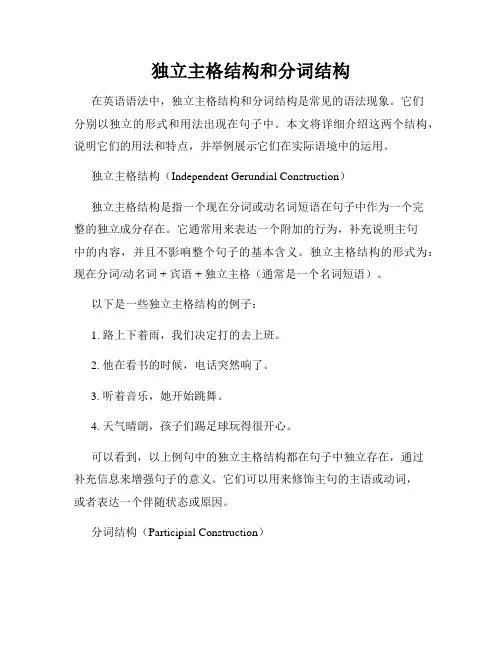
独立主格结构和分词结构在英语语法中,独立主格结构和分词结构是常见的语法现象。
它们分别以独立的形式和用法出现在句子中。
本文将详细介绍这两个结构,说明它们的用法和特点,并举例展示它们在实际语境中的运用。
独立主格结构(Independent Gerundial Construction)独立主格结构是指一个现在分词或动名词短语在句子中作为一个完整的独立成分存在。
它通常用来表达一个附加的行为,补充说明主句中的内容,并且不影响整个句子的基本含义。
独立主格结构的形式为:现在分词/动名词 + 宾语 + 独立主格(通常是一个名词短语)。
以下是一些独立主格结构的例子:1. 路上下着雨,我们决定打的去上班。
2. 他在看书的时候,电话突然响了。
3. 听着音乐,她开始跳舞。
4. 天气晴朗,孩子们踢足球玩得很开心。
可以看到,以上例句中的独立主格结构都在句子中独立存在,通过补充信息来增强句子的意义。
它们可以用来修饰主句的主语或动词,或者表达一个伴随状态或原因。
分词结构(Participial Construction)分词结构是通过分词的形式在句子中充当句子成分的一种短语结构。
分词结构可以是现在分词(-ing形式)或过去分词(-ed或第三人称单数形式)。
分词结构常常用来修饰主语或宾语,并且能够形成定语从句或状语从句。
以下是一些分词结构的例子:1. 坐在沙发上,他看着电视。
2. 这本书是由著名作家写的。
3. 受伤的狗躺在路边。
可以看到,以上例句中的分词结构分别修饰了主语、宾语和介词短语,使得句子更加丰富和详细。
分词结构可以用来表达时间、原因、条件、方式、伴随等多种语义。
总结独立主格结构和分词结构是英语语法中常见的句子结构形式。
独立主格结构通过现在分词/动名词短语的形式在句子中独立存在,补充说明主句中的内容。
而分词结构则通过分词的形式修饰主语或宾语,起到进一步详细描述的作用。
这两个结构都能为句子增添信息,使其更加准确和丰富。
在实际应用中,我们可以根据句子的需要灵活运用独立主格结构和分词结构,以达到精准表达的目的。
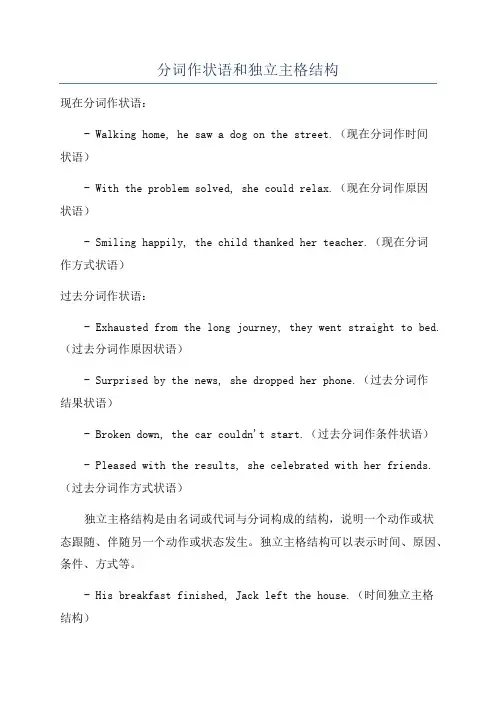
分词作状语和独立主格结构现在分词作状语:- Walking home, he saw a dog on the street.(现在分词作时间状语)- With the problem solved, she could relax.(现在分词作原因状语)- Smiling happily, the child thanked her teacher.(现在分词作方式状语)过去分词作状语:- Exhausted from the long journey, they went straight to bed.(过去分词作原因状语)- Surprised by the news, she dropped her phone.(过去分词作结果状语)- Broken down, the car couldn't start.(过去分词作条件状语)- Pleased with the results, she celebrated with her friends.(过去分词作方式状语)独立主格结构是由名词或代词与分词构成的结构,说明一个动作或状态跟随、伴随另一个动作或状态发生。
独立主格结构可以表示时间、原因、条件、方式等。
- His breakfast finished, Jack left the house.(时间独立主格结构)- The rain stopped, the players continued the game.(条件独立主格结构)- The cake eaten, the children happily played in the garden.(原因独立主格结构)- The teacher angry, the students were silent.(方式独立主格结构)需要注意的是,独立主格结构通常放在句子的开头或结尾,用逗号与主句分隔开来。
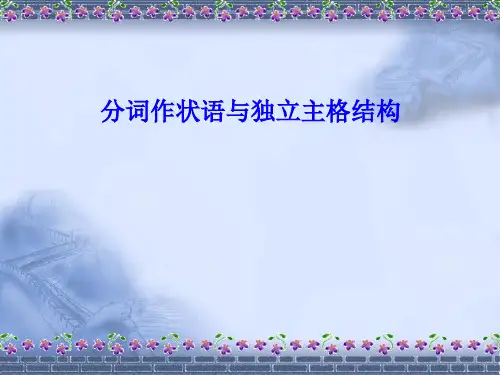
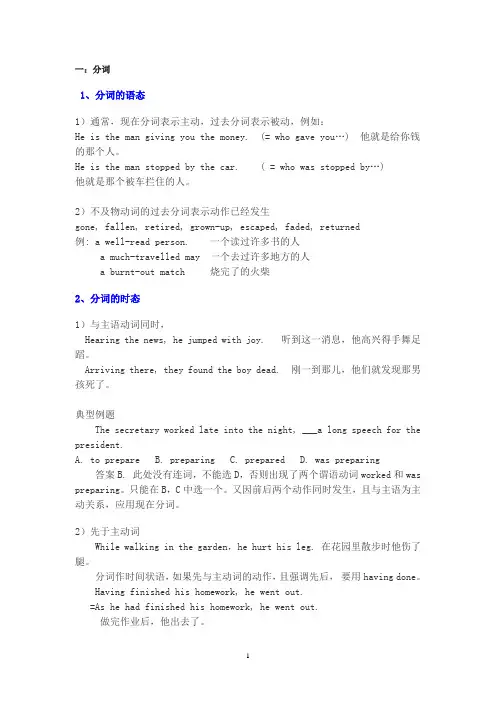
一:分词1、分词的语态1)通常,现在分词表示主动,过去分词表示被动,例如:He is the man giving you the money. (= who gave you…)他就是给你钱的那个人。
He is the man stopped by the car. ( = who was stopped by…)他就是那个被车拦住的人。
2)不及物动词的过去分词表示动作已经发生gone, fallen, retired, grown-up, escaped, faded, returned例: a well-read person. 一个读过许多书的人a much-travelled may 一个去过许多地方的人a burnt-out match 烧完了的火柴2、分词的时态1)与主语动词同时,Hearing the news, he jumped with joy. 听到这一消息,他高兴得手舞足蹈。
Arriving there, they found the boy dead. 刚一到那儿,他们就发现那男孩死了。
典型例题The secretary worked late into the night, ___a long speech for the president.A. to prepareB. preparingC. preparedD. was preparing答案B. 此处没有连词,不能选D,否则出现了两个谓语动词worked和was preparing。
只能在B,C中选一个。
又因前后两个动作同时发生,且与主语为主动关系,应用现在分词。
2)先于主动词While walking in the garden,he hurt his leg. 在花园里散步时他伤了腿。
分词作时间状语,如果先与主动词的动作,且强调先后,要用having done。
Having finished his homework, he went out.=As he had finished his homework, he went out.做完作业后,他出去了。
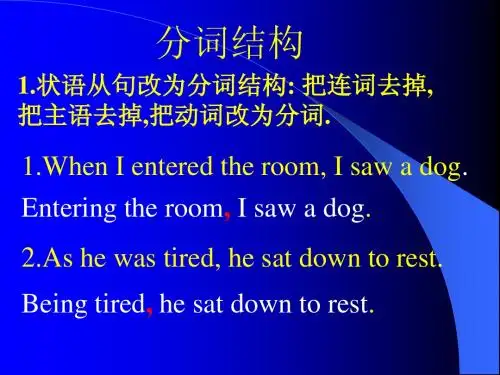
独立分词结构和独立主格结构
首先,我们来谈谈独立分词结构。
独立分词结构是指一个句子中的分词短语在形式上与句子其他成分相独立,但在意义上与句子其他成分有一定的逻辑关系。
这种结构常常用来表示时间、原因、条件、让步等关系。
例如,“天气晴朗,他们踏着轻快的步伐走进了公园。
”句中的“天气晴朗”和“踏着轻快的步伐”就构成了独立分词结构,它们分别表示的是时间和方式,与主句“他们走进了公园”有一定的逻辑关系。
其次,我们来谈谈独立主格结构。
独立主格结构是指一个句子中的名词或代词与一个动名词或动词不定式构成的结构,在形式上与句子其他成分相独立,但在意义上与句子其他成分有一定的逻辑关系。
这种结构常常用来表示伴随、原因、条件、目的等关系。
例如,“她站在门口,等待着朋友的到来。
”句中的“她”和“等待着朋友的到来”构成了独立主格结构,表示的是伴随关系,与主句“她站在门口”有一定的逻辑关系。
总的来说,独立分词结构和独立主格结构都是句子中常见的结构形式,它们在形式上与句子其他成分相独立,在意义上与句子其
他成分有一定的逻辑关系,用来丰富句子的表达,使语言更加生动、丰富。
希望以上解释能够帮助你更好地理解这两种语法结构。
分词做状语和独立主格结构分词做状语:分词可以作为状语来修饰动词、形容词、副词等,来表示时间、原因、方式、条件、让步等等。
1.时间:- Having finished his homework, he went to bed.- After eating dinner, they went for a walk.- While studying for the exam, she listened to music.2.原因:- Being tired, she decided to take a break.- Seeing the dark clouds, we decided to stay indoors.- Not knowing the answer, he asked for help.3.方式:- The teacher explained the concept clearly, making it easy for everyone to understand.- He won the race by running faster than the others.4.条件:- If invited, I will attend the party.- Unless you apologize, I won't forgive you.5.让步:- Despite being tired, he continued working.- Although feeling sick, she still came to the meeting.- In spite of the rain, they went hiking.分词做独立主格结构:在句子中,独立主格结构是由名词、代词或分词构成的结构,它通常用逗号与主句分开。
独立主格结构对主句作补充说明和解释。
1.用名词构成的独立主格结构:- The sun shining brightly, we decided to go for a picnic.- The concert being cancelled, we had to make alternative plans.- Her parents out of town, she had to take care of her younger siblings.2.用代词构成的独立主格结构:- He leading the team, they were sure to win the game.- You working hard, success is within reach.- She being the oldest, she was always responsible for her younger siblings.3.用分词构成的独立主格结构:- Seeing the opportunity, she decided to seize it.- Knowing the answer, he confidently raised his hand.。
独立主格结构与过去分词作状语的区别在中文语法中,有一些结构和用法可能会让人感到困惑,尤其是在写作中。
其中,独立主格结构和过去分词作状语就是两个易混淆的地方。
本文将深入探讨这两种结构的区别,并且帮助读者更好地理解和运用它们。
1. 独立主格结构独立主格结构是指一个句子中的独立成分,通常由名词或代词与动词的-ing形式构成,用来表示时间、原因、条件、伴随等关系。
其作用是对整个句子进行修饰和补充说明,增加句子的信息量和表达的灵活性。
举个例子:- 雨停了,天晴了,我们整个人都变得轻松起来。
在这个句子中,“天晴了”是主要句子,“雨停了”是独立主格结构,表示时间上的先后关系,并且强调了天气转好后人们的心情也随之改变。
2. 过去分词作状语过去分词作状语是指动词的过去分词形式用来修饰主句或从句,表示时间、原因、条件、方式、结果等。
过去分词作状语通常与所修饰的动词有逻辑上的动宾关系,能够对动作进行修饰和说明。
举个例子:- 他饿了,所以走进了一家餐厅。
在这个句子中,“饿了”是过去分词作状语,表示原因,修饰并解释了他走进餐厅的动作。
过去分词作状语丰富了句子的表达方式,使语言更加生动。
3. 区别与联系独立主格结构和过去分词作状语在形式上有些相似,都是由名词或代词加动词-ing形式构成,而且在句子中都起到修饰和补充的作用。
但它们的使用场景和功能有所不同。
独立主格结构更加独立完整,在句子中可以独立成段,表达一种自成体系的含义。
过去分词作状语则更加依赖于所修饰的动词,是动作的一部分,起到对动作的说明和补充的作用。
4. 个人观点在实际写作中,独立主格结构和过去分词作状语的正确使用可以丰富句子的表达,增加句子的层次感和表现力。
对于作者来说,理解它们的区别和联系,能够帮助我们更好地灵活运用这两种结构,写出具有深度和广度的文章。
对于读者来说,掌握这些语法知识也能够帮助我们更好地理解文章的含义,提升阅读理解能力。
总结回顾通过本文的讨论,我们对独立主格结构和过去分词作状语有了更深入的理解。
分词作状语与独立主格结构一、分词作状语1.动名词作状语动名词作状语常用于表示动作的方式、原因、结果等。
- 动作原因:He was late for work because of oversleeping.(他睡过头了,所以上班迟到了。
)- 动作结果:The car stopped running, causing a traffic jam.(汽车停了下来,导致了交通堵塞。
)2.现在分词作状语现在分词作状语常用于表示动作的时间、条件、原因、伴随等。
- 动作时间:Walking in the park, he met his old friend.(他在公园散步时遇到了他的老朋友。
)- 动作条件:Unless given permission, you cannot enter the building.(除非得到许可,否则你不能进入建筑物。
)- 动作原因:His face turned pale, feeling sick.(他感觉不适,脸色变得苍白。
)- 动作伴随:She burst into tears, seeing the sad news.(她看到这个悲伤的消息时,忍不住哭了起来。
)二、独立主格结构独立主格结构是指句子中的现在分词或过去分词作为非限制性状语,与主语关系疏远,独立于主句的结构。
独立主格结构一般用于表示时间、原因、条件、伴随等含义。
1.现在分词作独立主格结构现在分词作独立主格结构时,其逻辑主语通常与主句的主语不同,表示主句动作发生的时间、条件、原因、伴随等。
- 动作时间:The sun having set, we decided to go home.(太阳已经下山,我们决定回家。
)- 动作条件:The weather being fine, we went for a walk.(天气好的时候,我们去散步了。
)- 动作原因:Her husband having lost his job, she had to support the family.(她丈夫失业了,她不得不养家糊口。
不定式、动名词、分词、独立主格结构用法之区别总述:分词短语作定语时,相当一个定语从句;单个现在分词作定语,常前置;单个过去分词常后置,表一次具体动作;而前置表通常状况。
非谓语的否定式是把not置于非谓语动词前。
分词短语作状语时,相当于各种状语从句,即各种状语从句的主语与主句主语相同,去掉连词和从句主语, 把谓语动词改为非谓语形式;当从句主语与主句主语不同时,则主语不能去掉,即变成独立主格结构, 但不能作定语和补语。
不定式表示(过去或将来)具体某一次动作,强调全过程;或表示将要发生的动作。
不定式表示一般状况与动名词用法相同。
不定式还可做目的状语和结果状语。
单个动名词做主语,谓语用单数;做表语时, 表示主语的性质或具体内容。
一、不定式1、to+动原, 叫做不定式,与动名词、分词一起叫做非谓语形式。
其复合结构也一样;作使役、感观V宾补时,不带to;而当这些动词变成被动语态时要加上to。
省to :(1)help sb / sth (to)动原、don’t dare (to)+动原、prefer to +动原+rather than+(to)动原、do sth but / except (to)+动原, (2)what引导主语从句, everything / all / the bes t 所带定语从句关系代词作do的宾语,则作表语的不定式to可省; (3)and并列多个不定式,第一个以后to可省。
※too + adj / adv+ to动原;adj / adv + enough to +动原;manage / fail to do appeal to sb/sth to do approve of sb/sth to do only to do 不表将要做某事arrange for sb/sth to do demand of sb/sth to do 感观动词+sb/sth do○1I saw her walk across the square and go into a lane. ○2Set a thief to catch a thief.→She was seen to walk across the square and go into a lane.○3She is too young to go to school.○4I often heard him sing in the next room. ○5It’s a pleasure to manaage to get here.○6What / All I want to do is (to) help you with your study. ○7He is old enough to join the army.○8Would you be so kind as to help me with my English study? ○9To see is to believe. or Seeing is believing.○10It’s (of) no use regretting / to regret what has been done. ○11It’s worthwhile writing/to write it all out again. ○12To err is human, to forgive is divine.犯错是凡人,宽恕是圣人.○13Simon had no choice but to work hard then.○14Despite a heavy snow, the children are still looking forward to (not cancel) the outdoor activity at the weekend.○15My job is (water)all the flowers in the garden.○16I’m pleased to see you here. ○17The best that you can do is (manage) the stress in the day to minimize its impact on your health.2、(un)important, dangerous, terrible, (un)fit, surprising, (im)possible, easy, hard/ difficult, light / heavy,nice / beautiful, interesting, pleasant, expensive, weak等作表语时,不定式作条件、结果状语,用主动表示被动, 表明说话人对不定式动作看法或建议。
分词与独立主格结构
分词的结构
现在分词:doing/being done/having done/having been done
过去分词:done
分词用途
定语
单个的分词为定语通常是前置,特别是现在分词,其中现在分词表示主动且正在进行的含义,过去分词表示被动(及物动词)或已经完成的含义(不及物动词);对声音和表情的修饰常用过去分词;某些单个过去分词前置与后置有区别:
the given time/the time given
the wanted person/the person wanted
a concerned look/the persons concerned
an involved sentence/the persons involved
2) 分词短语为定语需要后置,相当于一个定语从句,用doing表示主动且正在进行的含义;用being done 表示被动且正在进行的含义;用done表示被动且已经完成的含义;用to be done 表示将来被动的含义,没有having done和having been done
The bridge ______(build)next year will join up the two islands.
The bridge ______(build)in 1960 is the first modern one in Chongqing.
The bridge ______(build)will be completed next week.
思考:是否所有的定语从句都可以改为分词结构吗?下列两个句子可以改为分词结构吗?The man who came this morning is his father.
Is there anyone who can drive a car?
表语
现在分词作为表语表示主语所具有的特征,过去分词为表语表示主语所处的状态
1). The animal and plants that they found there were (astonish)
2). I was (astonish) to learn that his long lost child had been found.
3). The news made us .(diappoint)
4). The mother went to visit Einstein. (puzzle)
5). Madame Curie found husband’s death .(shock)
6). I saw the boy very (excite)
7). Be brave. You look like a bird (frighten)
8). The fierce lion looks (frighten). Keep away from its cage or it will attack you.
9). The food served at the dinner party did not seem very (invite)
3.宾语补足语
现在分词在see, watch, hear, observe, notice, feel, find, glimpse, glance 等感官动词和look at, listen to 等短语动词,以及have, keep, get, catch, leave, set, start, send等使役动词后面与名词或代词构成复合宾语,作宾语补语的成分。
在动词see, hear, feel, watch, notice,perceive,observe, listen to, look at 后既可用现在分词做补语,也可用不定式做补语。
用现在分词表示动作正在进行,用不定式表示的动作的全过程已经完成。
过去分词可以在allow, ask, consider, desire, expect, feel, find, get, have, hear, imagine, keep, like, make, observe, order, permit, prefer, remember, request, require, see, urge 动词等后面作
宾语补足语。
4.状语
可以表示时间、条件、原因、结果、让步、伴随等。
分词做状语时,它的逻辑主语与句子的主语一致。
作状语的分词相当于一个状语从句。
Hearing the news, they all jumped with joy. 原因
Using what you know of word stems and word formations, you can make a guess at the meaning of a new word. 条件
The students went out of the classroom, laughing and talking. 伴随(主动)
Accompanied by his friend, he went to the railway station. 伴随(被动)
Given better attention, the plants could grow better. (条件)
He looked tired and depressed, visibly disturbed by the news of his mother's illness.(结果)
练习:
________(not hear)from his son,the mother worried a great deal.
_____________(give)such a good chance, how coul you let it slip away?
________(see)from the top the mountain , our city looks more beautiful.
_____(see)nobody at home, I decided to come again.
现在分词或过去分词作状语时,有时可以在分词前加while,when, once, although, until, if 等连词。
When leaving the airport, she waved again and again to us.
While waiting for the train, I had a long talk with my sister about her work.
Once recovered, he threw himself into his work and made every effort to do it well.
Although working very hard, he failed to pass the final exam.
If translated word by word, the passage will be difficult to understand.
某些现在分词可用来表示说话人对所说的话所持的看法或态度,它们已变成固定词组,在句中作独立成分,与句子主语无关。
这类现在分词常见的有:
generally speaking(一般地说),strictly speaking(严格地说),judging from /by...(从……来判断),talking of...(说到……),considering...(考虑到……),supposing...(假定……)等。
如:
Generally speaking,it is not easy for a for eigner to learn Chinese well in a short time.Considering everything,it wasn't abad holiday.
独立主格结构
独立主格结构是由名词或代词+其他成分(分词、不定式、形容词、副词、介词短语)构成,相当于状语从句,用于书面语,逻辑主语与句子主语不一致
名词/主格代词+现在分词
Time permitting, we can finish the work.
名词/主格代词+过去分词
All things considered ,her suggestion is of greater value than yours.
名词/主格代词+adj./adv.
The meeting over, the students were dismissed.
名词/主格代词+不定式
The teacher to help us,we will succeed.
名词/主格代词+介词短语
The old farmer came back, a large basket on his shoulder.
with/without的复合结构。